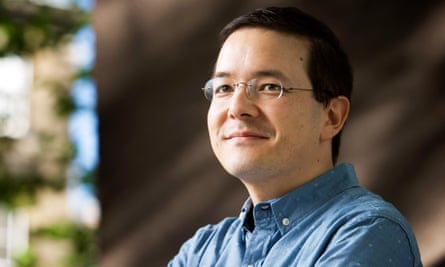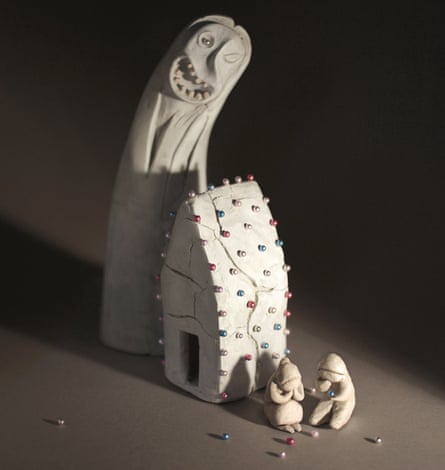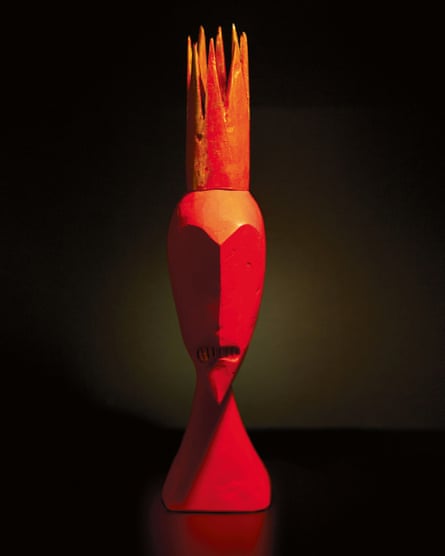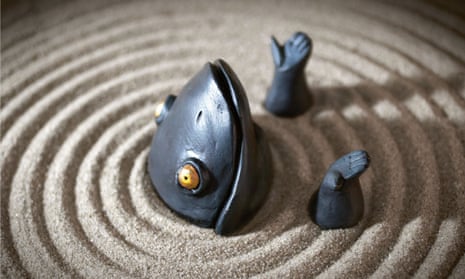Two centuries and a world apart, the Brothers Grimm and Shaun Tan share an ability to confound those who attempt to categorise them. When the German Grimm siblings released the first edition of their tales in 1812, it was under the name Kinder-und Hausmärchen, or Children’s and Household Tales, a title that belied the incest, infanticide and cannibalism found within. It didn’t sell. Even after they spent 45 years making increasingly child-friendly revisions over seven editions, their tales of princesses and princes, step-mothers and witches remained controversial; after the second world war, allied forces briefly banned the publication of the Grimm tales in Germany, believing that their violence and nationalism had fuelled Nazi savagery, while around the same time, Disney was hijacking them for saccharine retellings of Cinderella (featuring less eye-plucking) and Snow White (less death by dancing).
Tan also ostensibly writes books for children, but has a history of confusing adults with his surreal, often political picture books. The Australian artist quickly became famous for his intricately illustrated and laconic stories. He picked at the scabs of Australian history in books including The Rabbits (1998), a surreal allegory about colonisation, and The Arrival (2006), an entirely wordless graphic novel about refugees, and he pulled apart mental illness and depression in picture book The Red Tree (2001). Tan was dismissed by some on Australia’s right for producing “politically correct propaganda”; for those who loved him, the greatest criticism could be that his books “would almost rather be looked at than read”, as the New York Times once wrote.

Tan’s breakthrough came in 2011, when he won an Oscar for the short film version of his book The Lost Thing – narrated by fellow Perthling and Tan fan Tim Minchin – as well as the biggest award in children’s literature, the Astrid Lindgren prize. Suddenly, bookshops across Australia spawned “adult picture book” sections, to create a home for an author perhaps more likely to be appreciated by parents than children. Even Tan himself warns of The Rabbits: “It is not necessarily a good choice for pleasant bedtime reading.”
Growing up in the blistering heat of Perth’s suburbs, Tan remained indifferent to fairytales well into adulthood. “I know a lot of kids my age had a fascination with feudal times,” he says, “because it was so exotic. But I had weird ideas about what was fact and fiction; if you’d asked me if kings or castles were real, I would’ve said no, they’re made up. I remember having a massive argument with a kid because I said bats weren’t real.” He laughs. “That’s what happens when you’re so massively removed from where these stories come from – things like reindeer and fir trees and snow are just fiction.”
It wasn’t until he was an adult that Tan began to appreciate the Grimm tales, “for their complexity, ambiguity and endurance”. But when Tan was asked to illustrate Philip Pullman’s Grimm Tales by a German publisher in 2012, he was sceptical. Pullman wrote in his introduction that illustration did not suit the Grimm’s giant cast of two-dimensional archetypes. “That had always bothered me, too,” says Tan. “There are a lot of Grimm illustrators I love, like Arthur Rackham, but they always conflicted with my own mental images. I can only look at the pictures, or read the story, because I have a completely different take on the evil queen or the wolf or the fox.”

But Tan had long craved a sculptural project, and when he discovered Inuit soapstone carvings and pre-Columbian pottery on trips to Canada and Mexico, it sparked the idea of using small sculptures to tell the Grimm stories. The first tale he sculpted was Hansel and Gretel: a home adorned with cake decorations and a Babadook-ish witch looming nearby. Tan loved it. “With drawing, you have to redraw it until you get it right. The great thing about sculpture is that if a line is in the wrong place, you just push it,” he says. “And if it truly isn’t working, you just squeeze until it becomes something new.”
All between 6cm and 40cm high, Tan spent around three days on each of the 75 sculptures, moulding, painting, drying and photographing – another medium he is not known for and “spent a lot of time trying to get right so it didn’t look like some bad archaeological catalogue from the 70s”. Working in clay and papier mâché forced him to keep things simple: “I am not so good at doing simple things because I have this tendency to revisit again and again to add more stuff.”
The resulting figures are almost primitive in their simplicity, a nightmarish mix of cute and gruesome. Rapunzel doubling as her own tower is sweet; the bloodbath in Fitcher’s Bird less so. In his foreword, Neil Gaiman praises their tactility: “I want to squeeze them in my hands as I walk in the dark, to put them in my pockets and feel them there, reassuring me … [Tan] makes me wonder what damage I could do with them, how badly I could hurt someone if I hit them with a story.”

“Honestly, I thought it might be boring,” Tan says wryly. “I’m pleased it is not. When you’re doing a painting or drawing, you tend to get a little bit hypnotised with it, enamoured in a way someone looking at it will never be. But when you’re working quickly with clay, you never get hooked. It allows you objectivity, to notice when it is going wrong.”
Famously economical with words, Tan shortened each Grimm story into a snapshot, pinpointing what he calls “the DNA of the tale, the core that haunts people forever”; Little Red Riding Hood is reduced to a conversation between the girl and the wolf, The Frog King focuses on the princess’s dismissive thoughts towards her amphibian beau. For readers familiar with the tales, these are triggers; in the unfamiliar stories, the brevity of the writing makes for an unsettling, dreamlike experience, particularly in the bloody ones.
“It’s like when you wake up from a bad dream – you never remember the whole dream, you remember the most disturbing part,” Tan says. “So I eroded these stories down.” The sculptures also reflect this idea: some are as featureless as river stones, with Tan even sanding off the face of Snow White’s evil queen, a woman whose looks have been destroyed by jealousy.

Is any part of him attracted to the violence in the tales? “If I’m being honest, yes. I can’t handle violence in the real world, but in this transfigured state, it is kind of playful and interesting. But if you made any of these into a live-action film, they’d be too horrible to watch. The Juniper Tree is awful – imagine a film where a woman feeds a child to its father. It would make you feel awful! But there is something about depicting violence obliquely that makes it appealing.”
Tan is now working on other stories while keeping an eye on several TV and film adaptations “that seem to be eternally floating around, like a plane trapped at Heathrow in a holding pattern”. It’s a process he alludes to with contained frustration: “When they get done, they do have the potential to be fantastic, but at least when I decide to write a book, it always gets done.”
He has since sold many of the statues, but kept some delicate favourites – Hansel and Gretel and Hans My Hedgehog, which was also Pullman’s pick: “I said, ‘Sorry Philip, I can’t give you that one in good conscience, as it might fall apart.’ He’s happy with Briar Rose, though. I gave Neil The Juniper Tree.” Hang on, wasn’t that one of the more horrible ones? Tan cracks a smile. “Yeah, but I bet he likes it.”

Comments (…)
Sign in or create your Guardian account to join the discussion